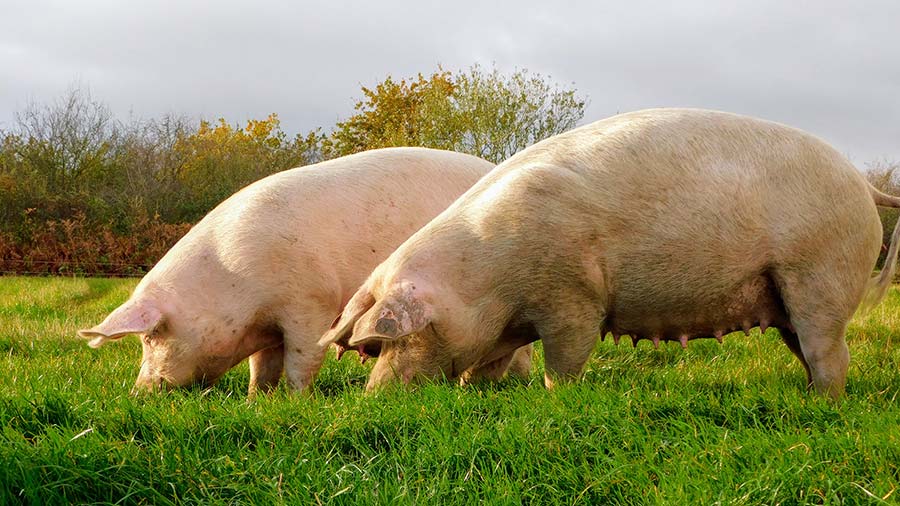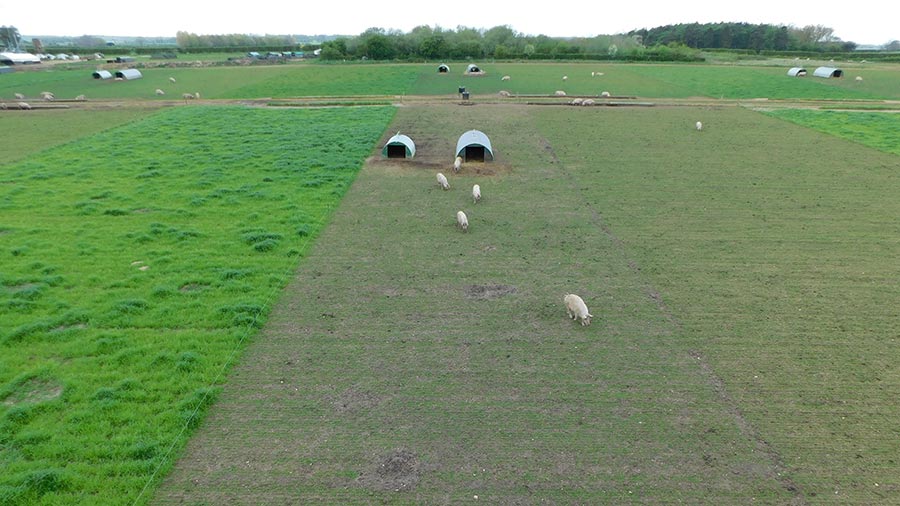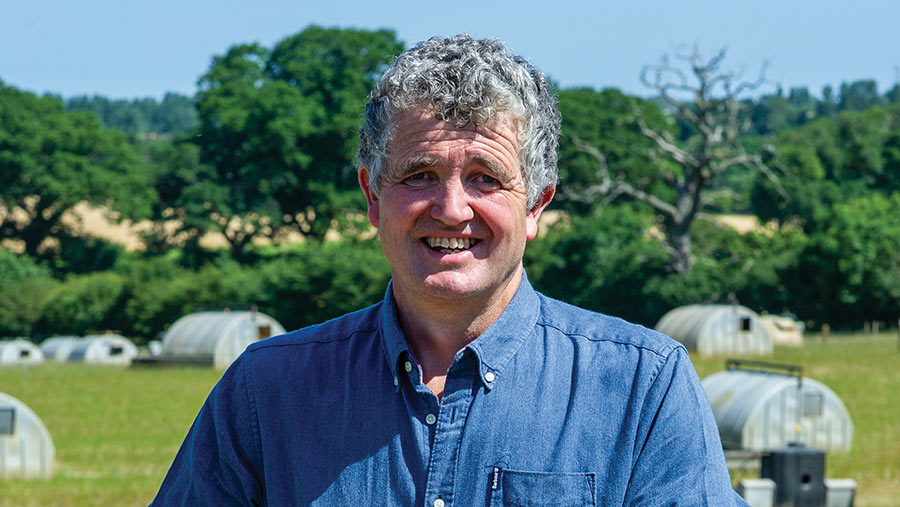Benefits of grass leys for outdoor pig units
 © Rob McGregor
© Rob McGregor Grass mixes can establish well and withstand grazing by outdoor pigs, helping protect soils and watercourses, a three-year trial has shown.
The trial took place in north Norfolk on 16ha (40 acres) across two sites run by LSB Pigs.
As well as finding which mix of species was most resilient, the trial looked at how successfully the grass mixes reduced soil loss, improved soil structure and minimised phosphate and nitrate losses through surface run-off and leaching to groundwater.
See more: On test – 3 types of shade for outdoor pigs
“East Anglia is home of a quarter of the world’s chalk streams,” says Ed Bramham-Jones, chief executive officer of Norfolk Rivers Trust, which was closely involved in the project.
“It’s very important to buffer and protect these streams, and once sediment gets into their chalk gravel beds, you can’t get it out easily.”
Interventions to protect chalk streams include filter netting to catch sediment, and buffer strips. These all work, he says, but what happens in the middle of fields is also critical.
“There’s a huge cost [to farmers] in lost soil – and once it’s gone, it’s gone. We’re seeing weather patterns changing dramatically, so putting in systems to mitigate risks is key.”
Types of mix
Paddocks were seeded in August 2020 following winter barley on light soil with a fallow mix of Italian ryegrass (IRG), vetch, bird’s-foot trefoil and red clover, sown at 20kg/ha, or a grass mix of strong creeping red fescue, an intermediate triploid perennial ryegrass (PRG), a late PRG and a late triploid PRG, sown at 35kg/ha.
A third mix of tall-leaved fescue, festulolium, perennial chicory, plantain, agricultural burnet and yarrow fell out of the trial because a large part of the trial site had compacted soil and establishment was poor.
Once established, dry sows, stocked at 5.7/ha, had either full access to the ley, or full access to a central area and one side for nine weeks, and then the central area and the other side for nine weeks. This “flip” system allowed for rest periods.

© Ed Bramham-Jones
Soil and green cover assessment
Grass cover and soil structure were monitored using visual assessment, worm counts and biomass imagery.
The grass mix proved more resilient than the fallow mix, according to Jim Egan, technical adviser at King’s Crops, which supplied the seed.
Bare areas were appearing in the fallow mix by autumn 2021, and by the following spring, the overall cover was thinning, and annual weeds were prevalent.
The IRG in the mix recovered somewhat, but by April this year, there remained much less cover overall.
Key lessons for successful green cover
- Include creeping red fescue in the mix – the creeping habit is key
- Ensure good and timely establishment
- Use a “flip” paddock system
Source: Jim Egan, King’s Crops
Earthworm counts improved during the trial, says Jim, from an average of three in each spade width to more than 10 in April this year. “The highest number of worms was 17 where the grass was in the best condition,” he says.
Surface ground temperature on paddocks with grass cover was also up to 8C lower in summer than bare areas, adds Ed.
Soil nutrient assessment
Fiona Wood, catchment management scientist at Anglian Water, found the following:
- Distribution of dung by pigs across the paddocks was even, benefiting management of the following crop
- Soil mineral nitrogen (SMN) built up over the trial period
- Where green cover/rooting was poorer, N could dissipate significantly over winter
- Autumn SMN build-up was lower under grass, but seemed more stable and increased further over winter
- Barer/weedy paddocks could also accumulate N if grazed over winter, but only in dry conditions
- 50kg/ha SMN was left after pigs, plus 30-40kg/ha of potentially mineralisable nitrogen (PMN).
Fiona advises testing for SMN and PMN and making allowances in N recommendations.
She recommends destroying the sward in spring, before a spring crop, rather than in autumn, to realise the benefits to the arable rotation and avoid environmental risks.
Farmer perspective

Rob McGregor © Jason Bye
Rob McGregor, manager at LSB Pigs and Farmer Focus writer, found sow health and welfare improved on grass:
- Sows were fitter and less constipated at farrowing
- Number of piglets born dead fell from 0.75 to 0.5 pigs a litter
- Contentment and gut fill from grazing reduced consumption of straw, halving usage in group-housed areas.
Conditions for staff are also much improved, with far less dust in summer and mud in winter.
“I’m really happy with what we achieved and it’s really hard to find a negative, as long as you have a co-operative landlord. It takes planning to make it work,” he says.
This can be helped by a collaborative partnership approach, says Ed.
“It’s best when progress is being led from farms up. We’re seeing policymakers going to where projects are happening, and they can help guide future policy. Being on the front foot is key.”
Sources of help
- Norfolk Rivers Trust: Funding and support for risk mapping and monitoring, and opportunities for collaborative partnerships
- Catchment Sensitive Farming (CSF): Advice and grant aid for improvements to air and water quality and natural flood management
- Adas: Free advice (contracted by CSF) on nutrient planning, storage capacity and slurry/muck management
10 top tips to reduce environmental risks from outdoor pig production
1. Check for special designations or restrictions
Use Magic Maps to check for source protection zones, nitrate vulnerable zones, sites of special scientific interest, boreholes and watercourses
2. Work out where surface water could travel
Plot the flow of any ditch, stream, track, road network or gateway to help establish the route water could take and what it could connect with, and plan mitigation such as buffer strips (minimum 10m wide)
3. Visit fields regularly before taking them on
Coarse loamy sands through to sandy loams are generally suitable; silty loams are not. Fields with multiple soil types will require more complex management
4. Get specialist help to identify any problems
Check for soil pans, capping and compaction. If renting land, agree with the landowner who is going to do what work before, during and after the pigs are on the land
5. Protect soils with green cover
Growing crops take up soil mineral nitrogen and cut the risk of nitrate leaching in winter. Where possible, establish cover early and before pigs move onto the site. Avoid following potatoes, maize or root crops with pigs
6. Identify no-go areas
Buffer strips will not work if they are driven on, and vehicle tracks can be a pathway for run-off. Consider pollen/nectar strips, along with buffers, to enhance biodiversity
7. Deal with surface water at source
Deal with the source of the surface water or use short-catch ditches that can be desilted as required. Avoid using soakaways or silt traps for contaminated water
8. Use pig troughs
Feed pigs using troughs rather than spreading feed on the ground to avoid damage to soil structure from rooting
9. Check water troughs and drinkers regularly
Fix leaks as soon as they are spotted, and move troughs/drinkers if the land around them is becoming poached
10. Be prepared to shut or rest pens
Pigs may need to be moved in poor/very wet conditions. Remember to rotate fields
Source: Environment Agency. To receive these tips on a laminated cab card, email Thomas.burling@environment-agency.gov.uk
The speakers presented their findings at a recent AHDB workshop in Swaffham, Norfolk.
